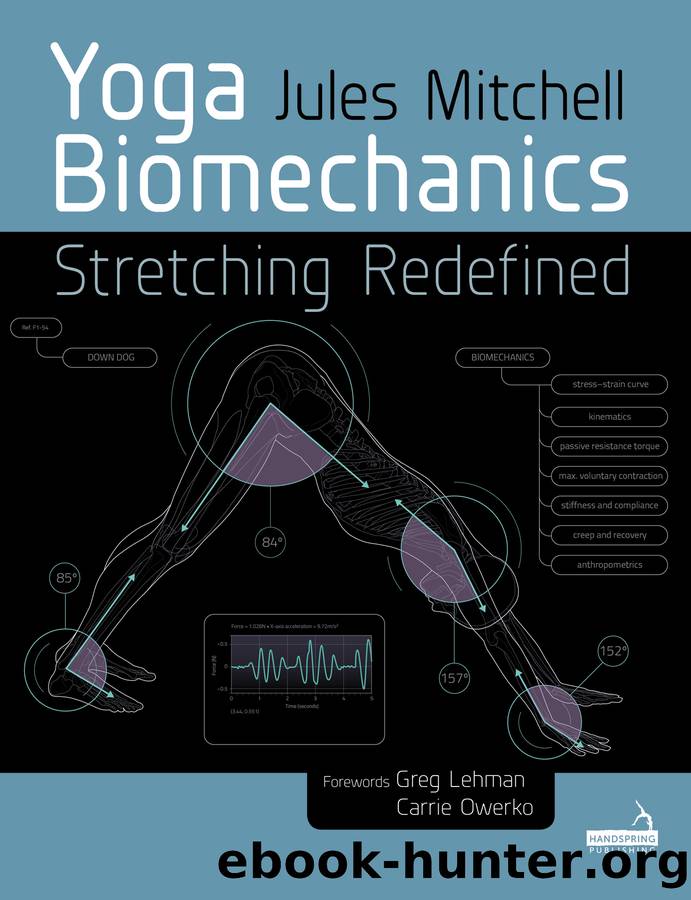Yoga Biomechanics by Jules Mitchell;

Author:Jules Mitchell;
Language: eng
Format: epub
ISBN: 9781909141629
Publisher: Handspring Publishing Limited
Published: 2019-02-22T00:00:00+00:00
In recent years, scientists have been in collaboration to establish an international standard nomenclature to reflect the surge of research on different fascial structures (Table 4.3). As you can imagine this process is slow and not without debate. In 2009 fascia scientists proposed a recommended language and naming of connective tissue proper that included 12 categories of fascia, including aponeuroses (broad flat sheets of tendon-like tissue), interosseous membranes (a connective tissue membrane between two bones such as ulna and radius), and the periosteum (connective tissue membrane surrounding bone) but excluding tendons, ligaments, and joint capsules (Langevin and Huijing, 2009).
In 2016, the committee published a paper with a proposed definition of fascia: âA fascia is a sheath, a sheet or any other dissectible aggregation of connective tissue to attach, enclose and separate muscles, bones, organs, blood vessels and nerves, etc.â (Adstrum et al., 2016). Note that a fascia refers to a general category of tissue but not all fasciae (the plural of fascia) have the same behavior or function. Therefore, when speaking of a specific fascia, it is worth mentioning the category from the above table.
Moreover, if we have many fasciae with specific functions, we can assemble them all to create a system. For example, if we include the heart, arteries, capillaries, and veins, we have a cardiovascular system. Thus, the committee concurrently published a definition for a fascial system, different from a fascial tissue. Paraphrased and abbreviated for simplicity here, the definition explains that the fascial system encompasses all soft connective tissues to establish the all-pervasive web as a coordinated and holistically functioning unit while integrating with and enabling all other systems (Adstrum et al., 2016). One could argue the same of the cardiovascular system, or any other system for that matter. The continuity of the arteries and veins to the heart could imply they are the heart, just as the periosteum and an aponeurosis are both fascia. Moreover, the cardiovascular system is an independent system with its own function to transport blood, but it also integrates with and enables all other systems. When was the last time you saw a fully functioning human with a non-functioning cardiovascular system?
Shortly after publication, a rebuttal to the Adstrum (2016) paper presented the idea that fascia does not literally separate any structure. Body parts only separate through the act of dissection; therefore, fascia does not separate itself, we separate it. The author proposed this alternative definition: âA fascia is a sheath, a sheet or any other dissectible aggregation of connective tissue that attaches, encloses and delineates muscles, bones, organs, blood vessels and nerves, etc.â (Scarr, 2016). After additional expert contributions, the original team slightly altered the wording in their fascial system definition but maintained the wording for the fascia definition pending feedback from the Federative International Committee on Anatomical Terminology (Stecco et al., 2018). I present this information here to highlight the conflict and collaboration of the process and that semantics in anatomy do matter greatly. Until standard nomenclature is accepted, we can
Download
This site does not store any files on its server. We only index and link to content provided by other sites. Please contact the content providers to delete copyright contents if any and email us, we'll remove relevant links or contents immediately.
Bodyweight Strength Training by Jay Cardiello(7185)
Tools of Titans by Timothy Ferriss(6950)
Born to Run: by Christopher McDougall(6263)
Inner Engineering: A Yogi's Guide to Joy by Sadhguru(5897)
Asking the Right Questions: A Guide to Critical Thinking by M. Neil Browne & Stuart M. Keeley(4576)
The Fat Loss Plan by Joe Wicks(4239)
Bodyweight Strength Training Anatomy by Bret Contreras(4061)
Yoga Anatomy by Kaminoff Leslie(3702)
Science and Development of Muscle Hypertrophy by Brad Schoenfeld(3578)
Dynamic Alignment Through Imagery by Eric Franklin(3489)
The Four-Pack Revolution by Chael Sonnen & Ryan Parsons(3485)
ACSM's Complete Guide to Fitness & Health by ACSM(3469)
Yoga Anatomy by Leslie Kaminoff & Amy Matthews(3396)
Bodyweight Strength Training: 12 Weeks to Build Muscle and Burn Fat by Jay Cardiello(3351)
The Ultimate Bodybuilding Cookbook by Kendall Lou Schmidt(3320)
Exercise Technique Manual for Resistance Training by National Strength & Conditioning Association(3292)
Nutrition for Sport, Exercise, and Health by Spano Marie & Kruskall Laura & Thomas D. Travis(3236)
Nutrition for Sport, Exercise, and Health by Marie Spano & Laura Kruskall & D. Travis Thomas(3233)
Yoga Therapy by Mark Stephens(3222)
